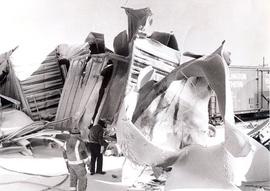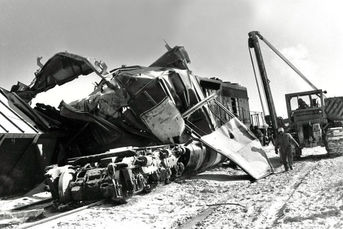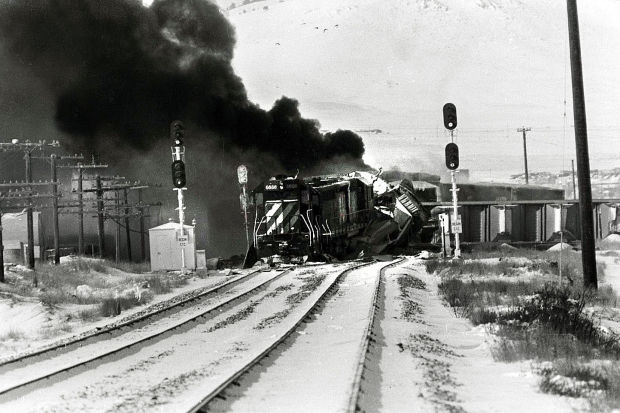 1989 Helena Train Wreck
1989 Helena Train Wreck
It was 27 degrees below zero and with the wind chill factored in it felt more like 60 below.
It wasn’t the best weather to be sitting in a train going up a mountain pass. That’s what was happening, however, Train 121 going up Mullan Pass with 49 cars and a couple engines.
That kind of cold played havoc with Montana Rail Link’s automatic switches, which allowed trains to switch from one set of tracks to another without stopping. Frozen up as they were, however, the engineers had to stop the train at every switch and have men get out and switch them by hand.
That got real cold real quick and the fact that the lead engine’s heater stopped working didn’t help matters. The men decided that on the next switch they’d get out, swap out the lead engine with one that had a working heater, and then couple the train back together and be on their way.
It was a good plan, and would have worked too had the weather not been so cold that it caused the air to actually leak out of the air brakes.
The men had just disconnected the engines and without the air brakes holding them in place – or the handbrakes that the crew should have set – the other 49 cars began to roll backwards. There was no way to stop them.
The cars shot down from near the top of the 5,566-foot Mullan Pass, gaining speed as they went. Along Greenhorn Creek and then past St. Louis Gulch to Spring Gulch the cars went, racing to Birdseye several miles away.
The cars passed the small community and continued on toward Helena. They made it all the way to the Benton Avenue crossing, right beside the Benton Avenue Cemetery that’d been opened in 1870 and which was right across the street from Carroll College, which had opened in 1909. There, parked on the tracks, was a work train.
The 49 cars moving at 35 to 45 miles per hour plowed into it at 5:30 in the morning, causing a massive pile-up and subsequent fire. A total of 15 cars derailed. That might have been the end of it except for the train car full of hydrogen peroxide that exploded eighteen minutes later.
Flames shot 20 to 30 feet into the air while metal and other debris was shot a mile outward in all directions. Most of the windows in the college’s women’s dorm were broken.
Girls were saved from injury because most had moved their beds away from the windows due to the cold, and they’d also “tucked in their curtains to keep out the cold, and these caught the exploding glass shards.
St. Charles Hall was shaken badly. The columns of the Cathedral of St. Helena were also damaged, even though they were a mile away.
Over at the Lundy Center, the diverse collection of plants in Staggering Ox’s window were frozen instantly when the windows there were shattered.
“I walked over and touched a leaf, and it shattered like glass in my hand,” one resident remembers. “Every plant died. Plumbing pipes froze and burst. The frozen yogurt machine was ruined. Water heaters were destroyed. Glass shards everywhere.”
Over on Ralph Street, 79-year-old Catherine DeBree was sleeping in her bedroom when “a train axel sailed over St. Charles Hall and tore through the roof” to land in her living room.
 1989 Helena Train Wreck
1989 Helena Train Wreck
Miraculously, no one died.
Power in Helena was disrupted and even 90 miles away in Great Falls they experienced some brownouts. In Helena none of the street or traffic lights worked and every business was dark.
When firefighters got to the Civic Center station they had to “wrestle open” the automatic station door manually “by pulling on a chain to raise it.”
Neighborhoods within 2 miles of the massive wreck and explosion were evacuated, largely over concerns about toxic gasses coming off of the hydrogen peroxide tank that’d caused much of the explosion. Another tank full of isopropyl alcohol was also to blame.
More than 3,500 people had to leave their homes because of the wreck.
“That’s when you really find out who your friends are,” one woman said of the event after calling people at 6 in the morning to see if she could stay with them.
I was 8-years-old when this happened, living in the Helena Valley past Lincoln Road at the time.
I remember my parents keeping the TV and most of the lights off that night, as the town was trying to conserve power so every house could get a little.
I was really upset by this, as I’d wanted to listen to my children’s record collection.
The train wreck caused more than $10 million in damages. It also gave Helenans quite the story to tell.
Notes
“1989 Helena train wreck.” Wikipedia. Web. Retrieved 29 October 2016. https://en.wikipedia.org/wiki/1989_Helena_train_wreck
“Collision and derailment of Montana Rail Link Freight Train with Locomotive Units and Hazardous Materials Release.” National Transportation Safety Board. Web. Retrieved 2 November 2016. http://www.ntsb.gov/investigations/AccidentReports/Pages/RAR8905.aspx
Lincoln, Marga. “Runaway Train: Today marks the 25th anniversary of one of Helena’s worst disasters.” Independent Record. 2 February 2014. Web. Retrieved 2 November 2016. http://helenair.com/news/local/today-marks-the-th-anniversary-of-one-of-helena-s/article_92b4017c-8bd9-11e3-9b48-001a4bcf887a.html
“Train Wreck Rocks Helena: some personal accounts.” Calamity Janet. Web. Retrieved 29 October 2016. http://www.calamityjanet.com/more-about-the-train-wreck.html


